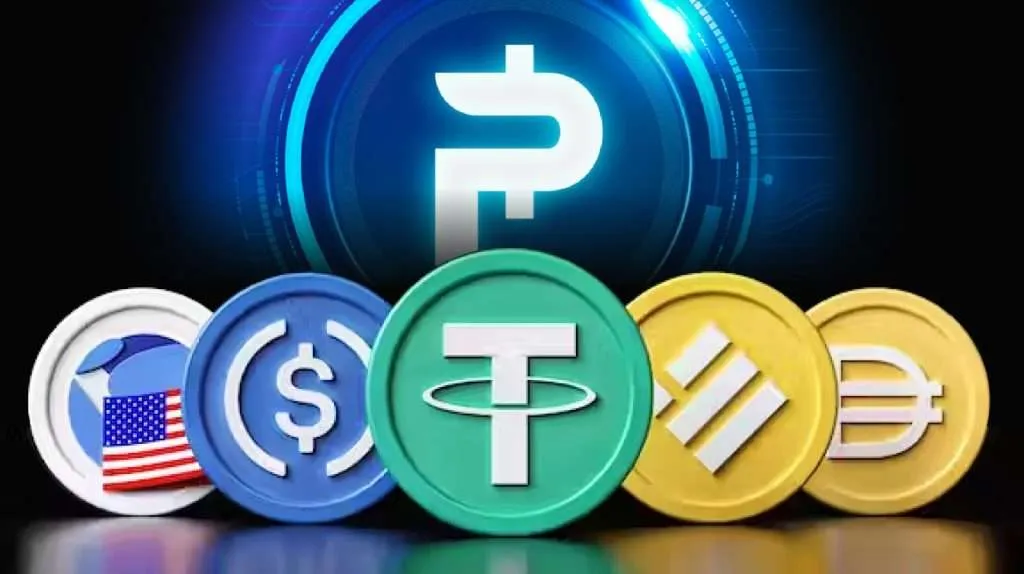Stablecoins have been one of the main catalysts pushing the crypto industry to a whole new level thanks to their ability to act as a bridge between traditional finance and blockchain assets. USP also shares some similarities with stablecoins, but does it fall under this category of tokens? Let’s delve deeper to find the answer.
What Is a Stablecoin?
Stablecoins are cryptocurrencies or tokens with their price pegged to a fiat currency, commodity, or basket of assets. In the majority of cases, a stablecoin simulates the price of a fiat currency, with the US dollar being -the most popular underlying asset. As a rule, stablecoins are backed by their underlying fiat based on a 1:1 ratio.
As of 2023, the three largest stablecoins by market cap are USDT, USDC, and BUSD. All three of them are in the top 10 largest cryptocurrencies and together account for over 12% of the entire crypto market, with a total market cap of $120+ billion as of January 2023.
Stablecoins have played a tremendous role in the adoption of crypto assets by institutional and retail investors thanks to their ability to reduce volatility to almost zero while giving easy access to any digital currency or asset. They have acted as a bridge between traditional finance and the crypto space, helping investors benefit from smooth on-ramp and off-ramp systems.
Stablecoins not only accelerated the adoption of cryptocurrencies but have been the main driver behind the rapid expansion of decentralized finance (DeFi), one of the most important trends in the blockchain space. At their peak, stablecoins accounted for over a third of the entire DeFi sector.
The success of stablecoins is explained by their ability to merge the stability and liquidity of fiat currencies with the unique features of blockchain, which relate to decentralization, security, speed, and transparency. These tokens can be integrated into traditional finance use cases, such as payments, cross-border transactions, and remittances, among others. The International Monetary Fund (IMF) has stressed the huge benefits of stablecoins since as early as 2019.
The dramatic failures of several algorithmic stablecoins, such as the collapse of Terra USD (UST), have put the crypto market in a bad light, but fiat-collateralized and crypto-collateralized stablecoins are proven to be resilient.
The Pros and Cons of Stablecoins
Stablecoins have become one of the main crypto asset types because of the following benefits:
- They address the most ardent problem of cryptocurrencies: volatility. Given that the price of a stablecoin is pegged to the value of its underlying asset, holders can better manage their funds.
- Stablecoins act as a gateway to the crypto and DeFi markets.
- Stablecoins enable users to conduct cross-border transactions at a low cost.
- These tokens can be easily integrated into digital applications, fostering a whole range of use cases.
- Stablecoins can act as programmable money, embedding functions to limit potential use by jurisdiction or eligibility.
The drawbacks of stablecoins are dictated by their design. While fiat-collateralized tokens are resilient, users have to trust a third party that acts as the issuer, which goes against the promise of decentralization. To reduce potential risks, users have to make sure the issuer is licensed and the collateral is audited.
Alternatively, even though algorithmic stablecoins are decentralized, their reputation has been damaged by several major failures.
What Is a Security Token?
Security tokens, also referred to as digital securities, are blockchain-based assets that represent traditional securities. Technically, they can resemble stablecoins. For example, many security tokens and stablecoins leverage the same public blockchain, which is Ethereum. However, security tokens are legally treated as securities and they are regulated.
If the majority of stablecoins are pegged to fiat currencies, security tokens are backed by securities. Traditional securities are financial instruments that hold value and can be traded on primary and secondary markets. Some examples of securities are corporate shares and government bonds.
A company can issue security tokens acting as shares to raise capital more efficiently by accessing a wider pool of investors. Security tokens are issued to the public through a Security Token Offering (STO), a fundraising mechanism that resembles an Initial Public Offering (IPO), although the former has way fewer regulatory requirements.
In the US, the Security and Exchange Commission (SEC) is the main financial regulator that supervises the issue and trade of security. Since security tokens are legally treated as securities, they must be registered with the SEC.
What makes security tokens different from traditional securities is the blockchain technology that backs them. Security tokens are hosted on a decentralized network, such as Ethereum, leveraging the features of their Layer-1 chain, which can revolve around data security, transparency, high-speed transactions at a low cost, and borderless reach, among others.
The different types of security tokens relate to the different forms of securities. The three main categories of security tokens are:
- Equity tokens – these tokens are backed by equities, such as company shares.
- Asset-backed tokens – they provide ownership rights in real-world assets, including real estate, commodities, and art.
- Debt tokens – these security tokens can represent all forms of debt-related instruments, including corporate and government bonds, real estate mortgages, and debt cash.
The Pros and Cons of Security Tokens
Security tokens can be more flexible than traditional counterparts and provide the following benefits:
- Liquidity – the tokenization process can increase the liquidity of any underlying asset, especially in the case of asset-backed tokens, which can represent illiquid assets like real estate and art. Security tokens can employ the fractional ownership feature, which enables institutional and/or retail investors to buy portions of the asset.
- Global reach – since blockchains are borderless, companies can raise funds from larger pools of investors dispersed across multiple jurisdictions.
- Programmability – unlike traditional securities, digital securities can embed all kinds of rules for better compliance. This enables the tokens to automate the management of the rights of holders.
- Convenience – STOs are more cost-efficient and flexible than IPOs, which come with a lot of obligations.
One of the drawbacks of security tokens is that they are usually traded on licensed platforms and are restricted to secondary markets. Also, many security tokens are open to accredited investors only.
Why Is USP Not a Stablecoin?
While the United States Property Coin (USP) shares some similarities with stablecoins, such as being backed by a portfolio of real-world assets, it has a fluctuating price and falls under the category of security tokens as it provides ownership rights over real estate assets. More specifically, USP is an asset-backed token.
USP represents fractional ownership of a real estate portfolio in the US, merging blockchain features with real estate to boost the liquidity of the underlying asset while ensuring decentralization and security of ownership. USP holders can take advantage of the potential long-term appreciation of the underlying property portfolio.
USP’s diversified portfolio includes US-based commercial real estate, including multifamily housing complexes, healthcare facilities, and hospitality properties. The property assets are located in high-demand urban markets spread across the country. The seed asset is a $10 million luxury multifamily property located in Venice Beach, California. The portfolio is designed to hedge against inflation, which has been accelerating to the highest levels in decades following the COVID-19 pandemic and the ongoing geopolitical tensions.
USP may be deemed a security for purposes of US securities laws. Accordingly, USP intends to comply with all applicable laws and regulations.















